Strong Rooms
Building a strong room in a house for protection during tropical cyclones
A strong room is a strengthened compartment within a house where people can shelter during a tropical cyclone.
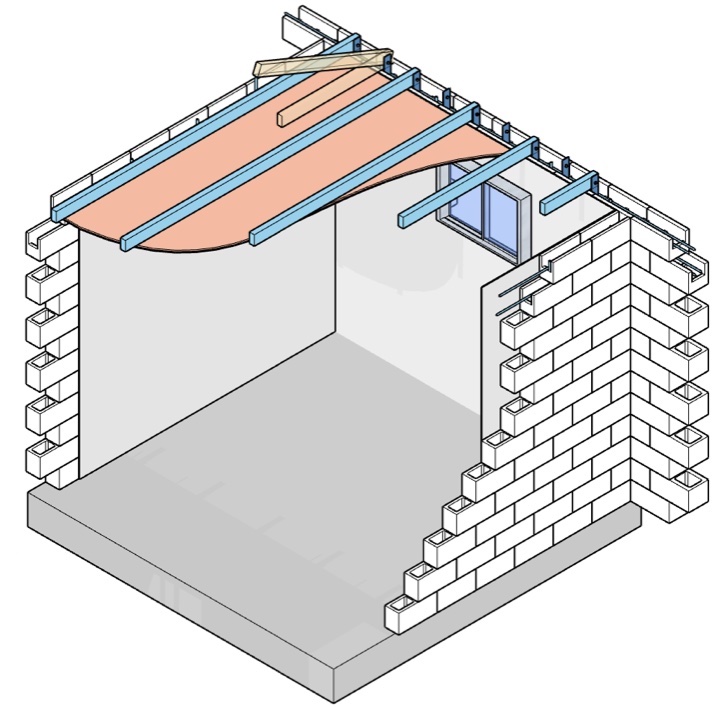
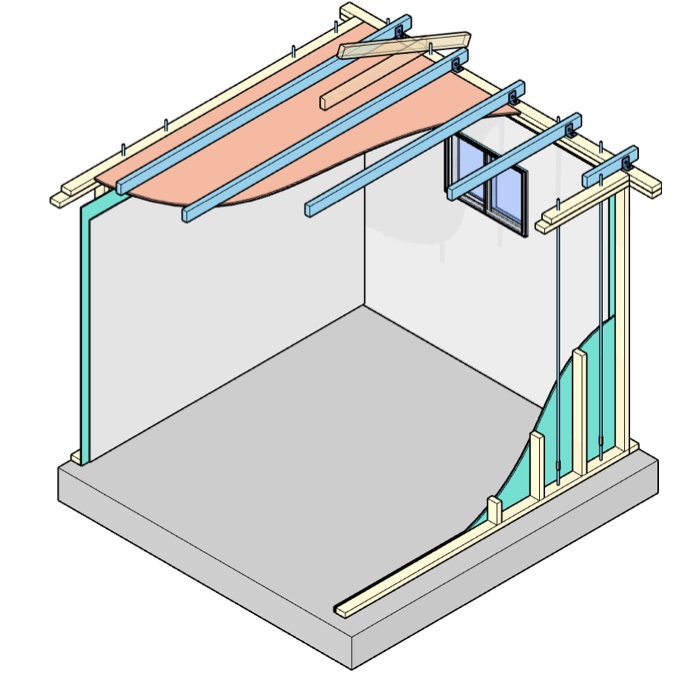
IMPORTANT: Strong rooms should not be built in houses that are in a storm-tide area or within a riverine flood zone. You MUST heed warnings from local emergency services and evacuate from these areas. Contact your Local Council to check whether your property is in a storm tide or flood area.
Guides for Homeowners
New Houses
Existing houses
Guides for Builders, Designers and Engineers
New Houses
This guide provides the detail for designers, engineers, builders and building surveyors to use either deemed-to-satisfy solutions or performance solutions in new houses to build strong rooms that can be marked as complying with the guide.
Existing houses
This guide provides the detail for designers, engineers, builders and building surveyors to use either deemed-to-satisfy solutions or performance solutions in an existing house to a reinforce a room to become a strong room that can be marked as complying with the guide.
Guide for Homeowners – New Houses
A strong room is a strengthened compartment within a house where people can shelter during a tropical cyclone.
They are designed to resist higher wind forces and larger wind-borne debris than the rest of your house and offer a higher level of protection from serious injury or death to you and your family. Strong rooms are designed to have a higher chance of remaining intact even if the rest of the house is severely damaged.
Including a strong room in a new home is relatively easy and cost-effective. The layout or design of the house may not need to change significantly – only the walls, ceiling, window, door and footings of the selected room need to be designed to meet the criteria in this Guide.
Strong rooms could be incorporated into bathrooms, walk-in pantries, walk-in wardrobes, garages, or the lower storeys of high-set houses. It is most cost-effective to design them into new houses.
Strong rooms could be used during severe (Category 3, 4 and 5) tropical cyclones and might be occupied for up to 12 hours.
A strong room that includes strong, debris-resistant materials in the walls and ceiling will help protect people sheltering in that room.
Tropical cyclones create wind-borne debris that could penetrate the outside walls of your house and put your family at risk. The photos below show a piece of timber that pierced a ceiling in a room where people were sheltering, and whole roofs that caused significant damage to walls.

Even if no debris penetrates the strong room, roof loss or damage can cause the ceiling and roof materials to fall into the room, as shown below.
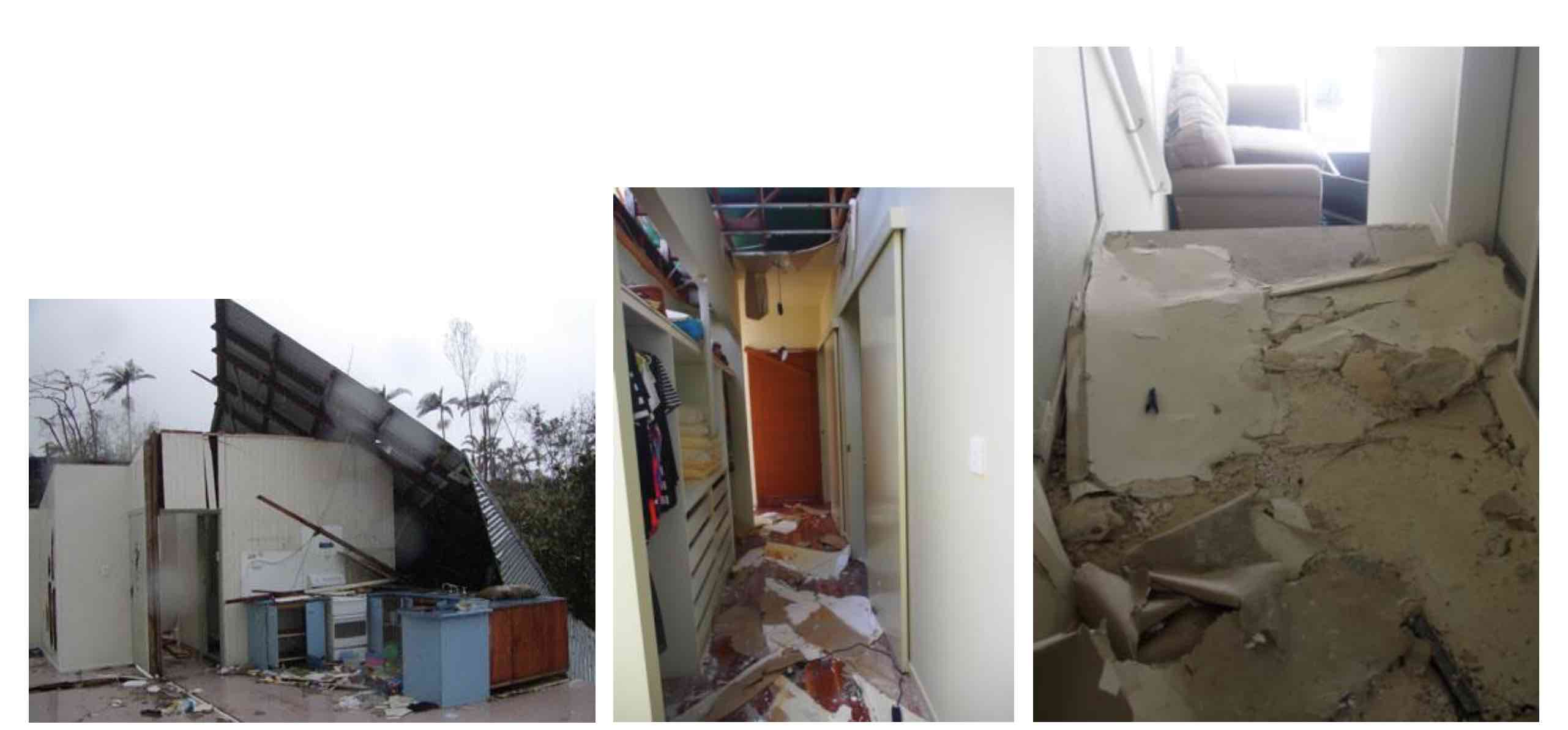
A strong room can help protect your family during a tropical cyclone even if the rest of your house is severely damaged by wind or wind-driven debris.
Tropical cyclones can cause significant damage to some houses, and people could be seriously injured. The Cyclone Testing Station has investigated damage to buildings following many past tropical cyclones. and has documented its findings in Technical Reports. Many people have described how they narrowly escaped serious injury when their roofs were lost, or their homes were hit by wind-borne debris. Some examples of damage to houses are shown below.
Why could your house be damaged during a future cyclone?
- It could be hit by large wind-borne debris such as broken sections of other house roofs, trees, unsecured boats, sheds or caravans.
- Some elements on your house could deteriorate, corrode, rot, crack or be affected by termites, so will no longer have the required strength. Even new houses require regular checks and maintenance.
- The cyclone could have wind speeds higher than what your house was designed to resist.

How does a strong room reduce your risk?
Strong rooms are designed and constructed to more stringent requirements than the other parts of your house, so will offer more protection from injury. If the rest of your house is severely damaged, at least the strong room in which you have been sheltering will provide a level of protection against wind-borne debris or parts of your damaged house.
Providing a strong room in your house will mean that you can be more confident about staying in your own home during a cyclone, rather than needing to move to a community cyclone shelter. Community cyclone shelters only really have room for people who must leave their homes because they live in a storm tide zone, or for people that live in caravans or other vulnerable accommodation.
Size
The size of your strong room will depend on the size of your house and the number of bedrooms, which relates to the number of people that could* live in your house.
* Even if there are currently only two people living in your house, but your house has three bedrooms, it is possible that more people could live in the house in the future.
- The recommended floor area is the number of bedrooms plus study/home office plus 2 (m2).
- The minimum floor area of the strong rooms provided in this Guide is 4 m2.
- The maximum wall length of the strong rooms provided in this Guide is 4 m.
- The strong room must have at least 1.2 m between any toilet pan and the door.
It is recommended that if the house has been or will be designed for universal access, the strong room should also contain features for universal access.
Suggested locations
There are several possible locations for a strong room:
- within your house
- attached to the outside wall of your house
- under your house (in a basement or at ground level of a high-set house) or
- a stand-alone above-ground room on your property.
People might need to shelter in a strong room for up to 12 hours, so access to toilet facilities and water needs to be considered.
The room used as the strong room must be kept free of clutter so it can be entered quickly and easily.
The door should be very strong so it can resist any wind pressures and wind-borne debris if your house is damaged. It also needs to be inward-opening, so you will be able to leave the room after the cyclone, even if debris is piled up against the outside of the door.
A room inside your house
A room without a window close to the centre of your house or a room with only a small window are ideal locations for a strong room.
A strong room could be located in any suitable room in a house with gable, flat or skillion roofs. But for houses with trussed hip roofs, the room should be located only under an area free of hips and valleys.
All doors into the strong room must comply with the requirements in this Guide.
- Bathroom – making the bathroom your strong room means that you would have access to water and perhaps a toilet during a cyclone. Universal design for access for people with disabilities has generally increased the size of bathrooms in new construction, so bathrooms are likely to provide the space and amenity required for people to shelter for many hours. (An added benefit of using a bathroom is that the extra layers and strength in framed wall systems required for strong rooms in bathrooms could also be used to accommodate the installation of handrails for people with disabilities.) You will need to consider the type of glass used in the window, shower screen and mirrors. You will also need to consider whether the shower screen will limit the space in the room. In some cases, the plumbing and wiring in a bathroom will pass through the strengthened wall and may increase the cost of the room.

- Large walk-in wardrobe – this space would need to be large enough and have a strong, inward-opening door.

- Bedroom or study.

A room attached to the house
- within a garage, patio or veranda under the main roof of a house
- on an outside wall of a house
The room could have a door to the inside of the house, or it could have an external door. The room should not be used for long-term storage so that it is accessible when needed.

Ground-level of a high-set house
Where the house is not in an area that could be inundated due to storm surge, riverine or flash flooding, then it may be possible to build an extra room under a high-set house.
Note that it is not appropriate to take shelter in an area that is likely to experience inundation from storm tide or riverine flooding. The room can only be classified as a strong room if the site is not in a storm surge or flood area.
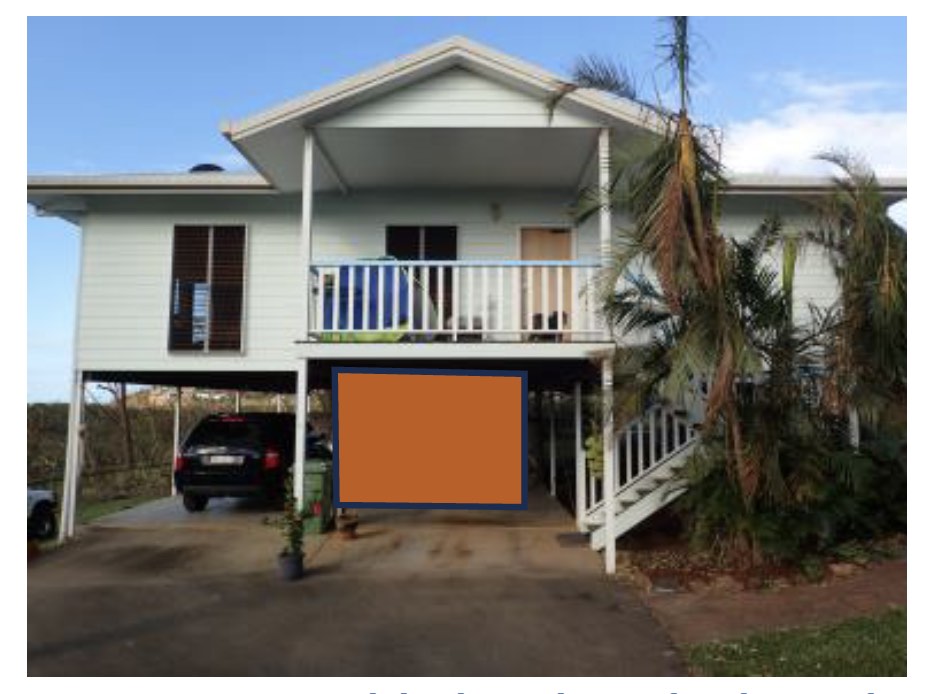
A stand-alone structure located close to the house
A free-standing strong room that is well-secured to the ground or footings and could be prefabricated or built on-site. The room shouldn’t be used for storage. You should not move between the strong room and your house during a cyclone, so you will need to prepare well.
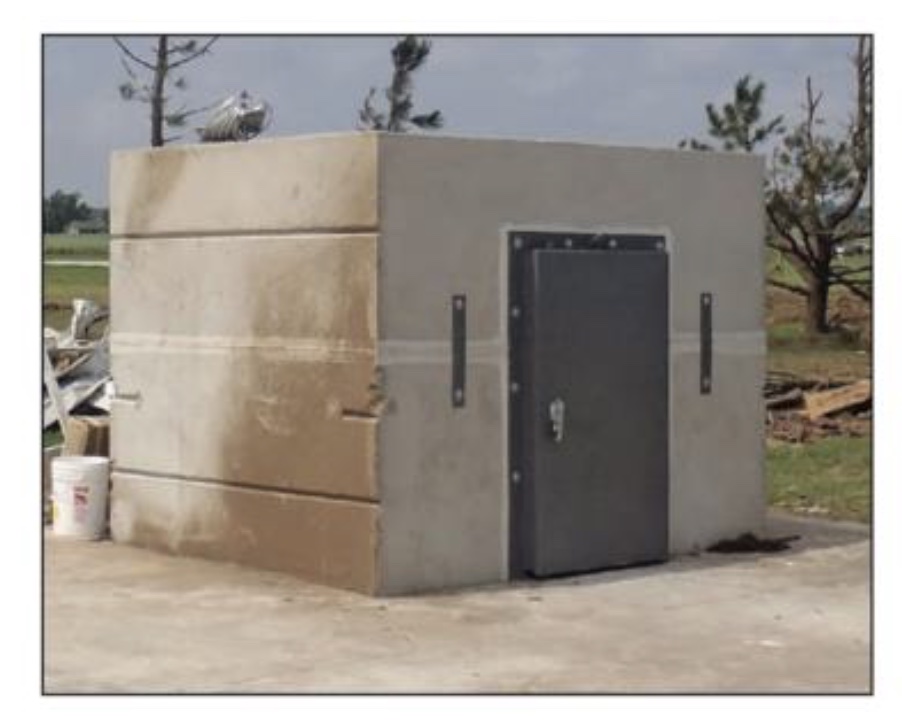
The main reason to include a strong room in your house is to keep your family safe during a severe tropical cyclone. During a cyclone, it may be cramped, stuffy, noisy and wet in the strong room.
You might need to shelter in the room for many hours, so you need to plan to bring some items that will make you more comfortable such as a battery-powered fan, small chairs, pillows and blankets.
Also, prepare your emergency kit and bring it into the strong room.
Although the strong room is designed and constructed to minimise the amount of wind-driven rain that will enter the strong room, some water will likely come into the room during the cyclone. Minimising the amount of water that comes in will also reduce air movement into the room, so it may also get stuffy after a few hours, particularly if the room is crowded.
How much will a strong room cost?
The cost of your strong room will depend on a combination of factors:
- Size
- Location within your house
- Materials used
- Number of external walls affected by the construction of the strong room
- Whether it will be built within the home or is free-standing
- Whether it is prefabricated or built on-site
- Rating and protection of the window and door
The cost could be around 3% to 6% of the cost of a new home.
Fire safety in a strong room
Simple actions can prevent a fire in your strong room.
- Turn off the electricity before going into the strong room – use battery torches for light.
- Don’t use candles, mosquito coils or camp stoves or other sources of flames while sheltering in your strong room.
- Don’t smoke in the strong room.
You should keep or bring the following fire control devices into the strong room:
- Fire extinguisher (not CO2)
- Fire blanket
Preparation of your strong room
Annual check
Your strong room should be inspected every October as part of your annual preparation for the cyclone season. The following components should be inspected and repaired or replaced if necessary:
- Door latch and hinges – check for corrosion, loose screws
- Window protection – check the condition of debris-rated screens and their attachment to the house
- Walls and ceilings are in good condition
- Fire extinguisher – right type (not CO2) fully charged, accessible and still current.
- Fire blanket – in good condition and still current
- Label – intact
- It is helpful to keep any records of alterations to the room for future owners
You could use the checklist provided to facilitate the checks. Future owners of the house should also be aware of the maintenance requirements for the strong room.
Immediately before using your strong room
Make sure the strong room contains:
- Cyclone kit, including:
- First aid kit
- Mobile phones
- Emergency contact details
- Battery-operated torch and radio
- Spare batteries
- Drinking water
- Non-perishable food (to be eaten cold) – can opener
- Toiletries
- Spare clothes and sturdy shoes,
- Important documents such as passports, identification, insurance information, driver’s license (stored in a waterproof bag)
- Medication prescribed for people that will shelter in the strong room
- Blankets for draping over glass e.g., mirrors, shower screens or doors.
- Fire extinguisher and blanket
- Crowbar or wrecking bar (to force the door or window if required) and a hammer and drift (bar or nail punch that is smaller than the pins in the hinges) to knock pins out of the hinges
- Any items required for pets sheltering with you
After using the strong room
Check for signs of damage to any part of the strong room and organise repairs if required. It is helpful to keep any records of alterations or major repairs to the room for future owners.
Future changes to the strong room
Your strong room must meet minimum design and construction requirements to provide the level of safety you expect. It will have a label prominently displayed to indicate that it complies with the requirements in this Guide. A copy of the label should also be placed in the electricity meter box. Refer to the example.
It is recommended that you record any changes, repairs, or maintenance of the strong room. Use the page provided at the end of this Guide. Any repairs or alterations must also comply with this Guide.
How do I get a strong room built? What are my next steps?
Discuss your ideas for a strong room with a qualified engineer, designer or builder.
- Discuss the concept of a strong room with your builder.
- Show your builder this Guide.
- Discuss which rooms could be strengthened to become a strong room.
- Ask your builder to provide an estimate of the extra costs for the different strong room options.
- Ask your builder to follow the requirements in this Guide for the strong room. (The rest of the house will be designed and constructed as usual.)
Useful Links
The following websites provide useful information about tropical cyclones, how they can damage buildings and what you can do to prepare your property to minimise damage and protect your family. There are also some useful links about construction and seeking approval for building work.
Information about tropical cyclones
Bureau of Meteorology:
http://www.bom.gov.au/cyclone/tropical-cyclone-knowledge-centre/
Cyclone Testing Station – Reports on previous cyclones and the damage they caused to houses:
https://www.jcu.edu.au/cyclone-testing-station/education/publications
Information about preparing your house for a tropical cyclone
Queensland Fire and Emergency Services (QFES) – Preparing for tropical cyclones:
https://www.qfes.qld.gov.au/prepare/cyclone
Queensland Government – Get Ready Queensland:
Western Australian Department of Fire and Emergency Services (DFES):
Preparing for tropical cyclones
Government of WA Department of Mines, Industry Regulation and Safety – Information on preparation for cyclones:
https://www.commerce.wa.gov.au/announcements/new-guide-help-safeguard-against-cyclones
Information about emergency kits
Queensland Government Get Ready Queensland:
https://www.getready.qld.gov.au/check-out-what-you-need
Government of Western Australia Department of Fire and Emergency Services:
https://www.dfes.wa.gov.au/hazard-information/emergency-kits
Information about building requirements
Queensland Government Department of Energy and Public Works (DEPW)
Advice for homeowners on building in Queensland:
https://www.qld.gov.au/housing/building-home
Western Australian Department of Mines, Industry, Regulation and Safety (DMIRS) – information on building regulations in Western Australia:
https://www.commerce.wa.gov.au/building-and-energy
Northern Territory Government Department of Infrastructure, Planning and Logistics – information on building regulations in the Northern Territory:
https://nt.gov.au/property/building/build-or-renovate-your-home/building-and-renovating-a-home
Please refer to the guide for more details.
Guide for Homeowners – Existing Houses
A strong room is a strengthened compartment within a house where people can shelter during a tropical cyclone.
They are designed to resist higher wind forces and larger wind-borne debris than the rest of your house and offer a higher level of protection from serious injury or death to you and your family. Strong rooms are designed to have a higher chance of remaining intact even if the rest of the house is severely damaged.
Strong rooms could be incorporated into bathrooms, walk-in pantries, walk-in wardrobes, garages, or the lower storeys of high-set houses. It is most cost-effective to design them into new houses, but it is also possible to strengthen a room in an existing house.
Strong rooms could be used during severe (Category 3, 4 and 5) tropical cyclones and might be occupied for up to 12 hours.
A strong room that includes strong, debris-resistant materials in the walls and ceiling will help protect people sheltering in that room.
Tropical cyclones create wind-borne debris that could penetrate the outside walls of your house and put your family at risk. The photos below show a piece of timber that pierced a ceiling in a room where people were sheltering, and whole roofs that caused significant damage to walls.

Even if no debris penetrates the strong room, roof loss or damage can cause the ceiling and roof materials to fall into the room, as shown below.

A strong room can help protect your family during a tropical cyclone even if the rest of your house is severely damaged by wind or wind-driven debris.
Tropical cyclones can cause significant damage to some houses, and people could be seriously injured. The Cyclone Testing Station has investigated damage to buildings following many past tropical cyclones. and has documented its findings in Technical Reports. Many people have described how they narrowly escaped serious injury when their roofs were lost, or their homes were hit by wind-borne debris. Some examples are shown below.
Why could your house be damaged during a future cyclone?
- It could be hit by large wind-borne debris such as broken sections of other house roofs, trees, unsecured boats, sheds or caravans.
- Some elements on your house could have deteriorated, corroded, rotted, cracked or be affected by termites, so no longer have the required strength.
- The cyclone could have wind speeds higher than what your house was designed to resist.
- Some older houses have not been designed and constructed to current standards and may not provide safe shelter. Damage investigations following tropical cyclones have indicated that a higher percentage of older houses are damaged compared with newer houses.

How does a strong room reduce your risk?
Strong rooms are designed and constructed to more stringent requirements than the other parts of your house, so will offer more protection from injury. If the rest of your house is severely damaged, at least the strong room in which you have been sheltering will provide a level of protection against wind-borne debris or parts of your damaged house.
Providing a strong room in your house will mean that you can be more confident about staying in your own home during a cyclone, rather than needing to move to a community cyclone shelter. Community cyclone shelters only really have room for people who must leave their homes because they live in a storm tide zone, or for people that live in caravans or other vulnerable accommodation.
Size
The size of your strong room will depend on the size of your house and the number of bedrooms, which relates to the number of people that could* live in your house.
* Even if there are currently only two people living in your house, but your house has three bedrooms, it is possible that more people could live in the house in the future.
- The recommended floor area is the number of bedrooms plus study/home office plus 2 (m2).
- The minimum floor area of the strong rooms provided in this Guide is 4 m2.
- The maximum wall length of the strong rooms provided in this Guide is 4 m.
- The strong room must have at least 1.2 m between any toilet pan and the door.
It is recommended that if the house has been or will be designed for universal access, the strong room should also contain features for universal access.
Suggested locations
There are several possible locations for a strong room:
- within your house
- attached to the outside wall of your house
- under your house (in a basement or at ground level of a high-set house) or
- a stand-alone above-ground room on your property.
People might need to shelter in a strong room for up to 12 hours, so access to toilet facilities and water needs to be considered.
The room used as the strong room must be kept free of clutter so it can be entered quickly and easily.
The door should be very strong so it can resist any wind pressures and wind-borne debris if your house is damaged. It also needs to be inward-opening, so you will be able to leave the room after the cyclone, even if debris is piled up against the outside of the door.
A room inside your house
A room without a window close to the centre of your house or a room with only a small window are ideal locations for a strong room.
A strong room could be located in any suitable room in a house with gable, flat or skillion roofs. But for houses with trussed hip roofs, the room should be located only under an area free of hips and valleys.
All doors into the strong room must comply with the requirements in this Guide.
- Bathroom – making the bathroom your strong room means that you would have access to water and perhaps a toilet during a cyclone. (An added benefit of using a bathroom is that the extra layers and strength in framed wall systems required for strong rooms in bathrooms could also be used to accommodate the installation of handrails for people with disabilities.) You will need to consider the type of glass used in the window, shower screen and mirrors. You will also need to consider whether the shower screen will limit the space in the room. In some cases, the plumbing and wiring in a bathroom will pass through the strengthened wall and may increase the cost of the room.

- Large walk-in wardrobe – this space would need to be large enough and have a strong, inward-opening door.

- Bedroom or study.

A room attached to the house
- within a garage, patio or veranda under the main roof of a house
- on an outside wall of a house

The room could have a door to the inside of the house, or it could have an external door. The room should not be used for long-term storage so that it is accessible when needed.
Ground-level of a high-set house
Where the house is not in an area that could be inundated due to storm surge, riverine or flash flooding, then it may be possible to build an extra room under a high-set house.
Note that it is not appropriate to take shelter in an area that is likely to experience inundation from storm tide or riverine flooding. The room can only be classified as a strong room if the site is not in a storm surge or flood area.

A stand-alone structure located close to the house
A free-standing strong room located on the grounds of the property may provide a cost-effective solution when it is difficult to retrofit a strong room into an existing house. The strong room must be well-secured to the ground or footings and could be prefabricated or built on-site. The room shouldn’t be used for storage. You should not move between the strong room and your house during a cyclone, so you will need to prepare well.

The main reason to include a strong room in your house is to keep your family safe during a severe tropical cyclone. During a cyclone, it may be cramped, stuffy, noisy and wet in the strong room.
You might need to shelter in the room for many hours, so you need to plan to bring some items that will make you more comfortable such as a battery-powered fan, small chairs, pillows and blankets.
Also, prepare your emergency kit and bring it into the strong room.
Although the strong room is designed and constructed to minimise the amount of wind-driven rain that will enter the strong room, some water will likely come into the room during the cyclone. Minimising the amount of water that comes in will also reduce air movement into the room, so it may also get stuffy after a few hours, particularly if the room is crowded.
How much will a strong room cost?
Building a strong room in an existing house usually costs more than including a strong room in a new home. The strength of the selected room (including foundations) must be assessed to ensure it can cope with the higher uplift and overturning forces during a cyclone. Some of the existing structure will need to be cut out and reinforced. For example, the room will need to be ‘gutted’ to reinforce the ceiling and walls, which could be done at the same time as a major renovation.
Constructing a separate stand-alone strong room might be a more cost-effective option for some existing houses.
A building permit will be required to retrofit a strong room into an existing house because the strong room is a structural component of the house.
The cost of your strong room will depend on a combination of factors:
- Size
- Location within your house
- Materials used
- Number of external walls affected by the construction of the strong room
- Whether it will be built within the home or is free-standing
- Whether it is prefabricated or built on-site
- Rating and protection of the window and door
The cost could be around $30 to $50K to retrofit a room in your existing home.
Fire safety in a strong room
You should keep or bring the following fire control devices into the strong room:
- Fire extinguisher (not CO2)
- Fire blanket
Simple actions can prevent a fire in your strong room.
- Turn off the electricity before going into the strong room – use battery torches for light.
- Don’t use candles, mosquito coils or camp stoves or other sources of flames while sheltering in your strong room.
- Don’t smoke in the strong room.
Preparation of your strong room
Annual check
Your strong room should be inspected every October as part of your annual preparation for the cyclone season. The following components should be inspected and repaired or replaced if necessary:
- Door latch and hinges – check for corrosion, loose screws
- Window protection – check the condition of debris-rated screens and their attachment to the house
- Walls and ceilings are in good condition
- Fire extinguisher – right type (not CO2) fully charged, accessible and still current.
- Fire blanket – in good condition and still current
- Label – intact
- It is helpful to keep any records of alterations to the room for future owners
You could use the checklist provided to facilitate the checks. Future owners of the house should also be aware of the maintenance requirements for the strong room.
Immediately before using your strong room
Make sure the strong room contains:
- Cyclone kit, including:
- First aid kit
- Mobile phones
- Emergency contact details
- Battery-operated torch and radio
- Spare batteries
- Drinking water
- Non-perishable food (to be eaten cold) – can opener
- Toiletries
- Spare clothes and sturdy shoes,
- Important documents such as passports, identification, insurance information, driver’s license (stored in a waterproof bag)
- Medication prescribed for people that will shelter in the strong room
- Blankets for draping over glass e.g., mirrors, shower screens or doors.
- Fire extinguisher and blanket
- Crowbar or wrecking bar (to force the door or window if required) and a hammer and drift (bar or nail punch that is smaller than the pins in the hinges) to knock pins out of the hinges
- Any items required for pets sheltering with you
After using the strong room
Check for signs of damage to any part of the strong room and organise repairs if required. It is helpful to keep any records of alterations or major repairs to the room for future owners.
Future changes to the strong room
Your strong room must meet minimum design and construction requirements to provide the level of safety you expect. It will have a label prominently displayed to indicate that it complies with the requirements in this Guide. A copy of the label should also be placed in the electricity meter box. Refer to the example.
It is recommended that you record any changes, repairs, or maintenance of the strong room. Use the page provided at the end of this Guide. Any repairs or alterations must also comply with this Guide.
How do I get a strong room built? What are my next steps?
Discuss your ideas for a strong room with a qualified engineer, designer or builder.
- Show your builder this Guide.
- Discuss which would be the most cost-effective room to upgrade to become a strong room and how it will affect the rest of your house (your builder will probably engage an engineer to help with this decision).
- Ask your builder to provide an estimate of the costs.
- Your builder will apply for a building permit. Structural building work requires building approval. Further details can be obtained from your local council.
- Ask the builder to follow the requirements in this Guide.
It is recommended that you use licenced builders and tradespeople to build your strong room.
Useful Links
The following websites provide useful information about tropical cyclones, how they can damage buildings and what you can do to prepare your property to minimise damage and protect your family. There are also some useful links about construction and seeking approval for building work.
Information about tropical cyclones
Bureau of Meteorology:
http://www.bom.gov.au/cyclone/tropical-cyclone-knowledge-centre/
Cyclone Testing Station – Reports on previous cyclones and the damage they caused to houses:
https://www.jcu.edu.au/cyclone-testing-station/education/publications
Information about preparing your house for a tropical cyclone
Queensland Fire and Emergency Services (QFES) – Preparing for tropical cyclones:
https://www.qfes.qld.gov.au/prepare/cyclone
Queensland Government – Get Ready Queensland:
Western Australian Department of Fire and Emergency Services (DFES):
Preparing for tropical cyclones
Government of WA Department of Mines, Industry Regulation and Safety – Information on preparation for cyclones:
https://www.commerce.wa.gov.au/announcements/new-guide-help-safeguard-against-cyclones
Information about emergency kits
Queensland Government Get Ready Queensland:
https://www.getready.qld.gov.au/check-out-what-you-need
Government of Western Australia Department of Fire and Emergency Services:
https://www.dfes.wa.gov.au/hazard-information/emergency-kits
Information about building requirements
Queensland Government Department of Energy and Public Works (DEPW)
Advice for homeowners on building in Queensland:
https://www.qld.gov.au/housing/building-home
Western Australian Department of Mines, Industry, Regulation and Safety (DMIRS) – information on building regulations in Western Australia:
https://www.commerce.wa.gov.au/building-and-energy
Northern Territory Government Department of Infrastructure, Planning and Logistics – information on building regulations in the Northern Territory:
https://nt.gov.au/property/building/build-or-renovate-your-home/building-and-renovating-a-home
Please refer to the guide for more details.